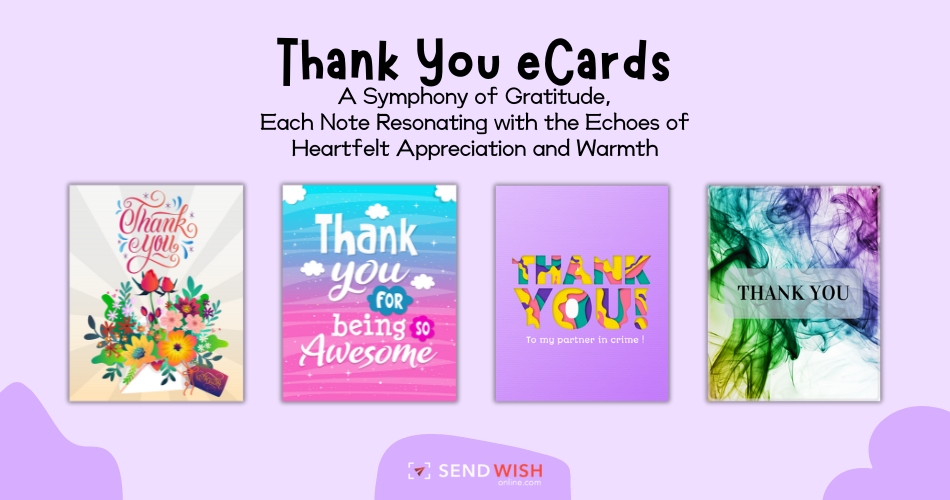A Brief History of Thank You Cards: Tracing the Tradition from Ancient Gratitude to Modern Etiquette
Introduction:
In a world filled with digital communication and instant messaging, the art of expressing gratitude through written words may seem like a fading tradition. However, the practice of sending Thank you ecards has a rich and storied history that dates back centuries. From ancient civilizations to modern times, the act of expressing gratitude through handwritten notes has evolved, reflecting changes in culture, technology, and social etiquette. In this article, we will trace the origins of thank you cards, exploring their journey from ancient gratitude to modern-day etiquette.
Ancient Gratitude:
The roots of expressing gratitude can be found in ancient civilizations where handwritten letters and messages were considered an essential means of communication. In ancient Egypt, for instance, papyrus scrolls were used to convey thanks for various reasons, such as receiving gifts or assistance. Similarly, in ancient China, handwritten letters expressing gratitude were common, particularly during festivals and special occasions.
The Birth of Thank You Notes:
The tradition of sending thank you notes as we know them today began to take shape during the Renaissance period in Europe. With the advent of the printing press, written correspondence became more accessible to the general public. People would send letters or notes of appreciation to express their thanks for acts of kindness, hospitality, or gifts received.
The Victorian Era and the Rise of Thank You Cards:
It was during the Victorian era that thank you cards emerged as a popular means of expressing gratitude. The advancements in printing technology, coupled with changes in social etiquette, led to the rise of beautifully designed cards specifically created for this purpose. These cards featured intricate designs, delicate illustrations, and heartfelt messages, often adorned with ribbons, lace, and other decorative elements. The Victorians placed great importance on proper etiquette and saw thank you cards as a way to convey their appreciation in a refined manner.
The Age of Mass Production and Commercialization:
In the early 20th century, the introduction of mass production techniques and the growth of the greeting card industry made thank you cards more accessible to a wider audience. The commercialization of thank you cards allowed people from different social classes to participate in the tradition of expressing gratitude. As a result, thank you cards became a staple in various cultures and societies.
Evolution in the Digital Age:
In recent decades, the advent of digital communication has significantly impacted the way people express gratitude. Electronic messages, emails, and social media platforms have become popular alternatives to handwritten thank you cards. However, the tangible and personal nature of physical thank you cards continues to hold a special place in people’s hearts. Many individuals still appreciate the time, effort, and thoughtfulness associated with receiving a handwritten note.
Modern Thank You Cards:
Today, thank you cards come in a wide variety of styles, designs, and formats. They can be simple and elegant or playful and vibrant, catering to individual preferences and occasions. Personalized thank you card, complete with handwritten messages, add an extra touch of sincerity and thoughtfulness. The digital age has also made it easier to create custom-designed thank you cards, allowing individuals to combine the convenience of technology with the personal touch of handwritten notes.
Cultural Variations:
Thank you cards and expressions of gratitude vary across different cultures. For example, in Japan, the practice of sending thank you cards, known as “Arigatou” cards, is deeply ingrained in their customs. These cards are often exchanged after weddings, funerals, or business transactions, and they convey a sense of respect, appreciation, and reciprocity.
Wedding Thank You Cards:
Wedding thank you cards hold a special place in the tradition of thank you cards. Newlyweds often send personalized cards to express their gratitude to guests for attending the wedding, offering gifts, and sharing in their joyous occasion. These cards are an important way to acknowledge the presence and support of loved ones during such a significant milestone.
Professional Thank You Cards:
Thank you cards also play a crucial role in professional settings. Individuals often send thank you cards to express appreciation for job interviews, networking opportunities, or acts of professional kindness. These cards help leave a positive impression and demonstrate professionalism, gratitude, and a genuine desire to maintain professional relationships.
Sympathy Thank You Cards:
During times of loss and bereavement, sympathy thank you cards provide a means to express gratitude for the support and condolences received from friends, family, and acquaintances. These cards offer comfort and serve as a way to acknowledge the kindness and compassion extended during difficult times.
Etiquette and Timing:
When it comes to sending thank you cards, timing and etiquette are important considerations. It is generally recommended to send thank you cards promptly after receiving a gift, attending an event, or receiving assistance. Expressing gratitude in a timely manner demonstrates thoughtfulness and respect for the sender’s gesture or effort.
Conclusion:
While the methods of expressing gratitude have evolved over time, the sentiment behind Free thank you ecards remains unchanged. From ancient civilizations to the digital age, these cards have served as a tangible expression of appreciation, respect, and gratitude. The tradition of sending thank you cards continues to thrive, reminding us of the enduring power of heartfelt appreciation and the importance of acknowledging the kindness and generosity of others. So, the next time you receive a thoughtful gesture or act of kindness, consider picking up a pen and expressing your gratitude through a thank you card, continuing a tradition that has spanned centuries.





